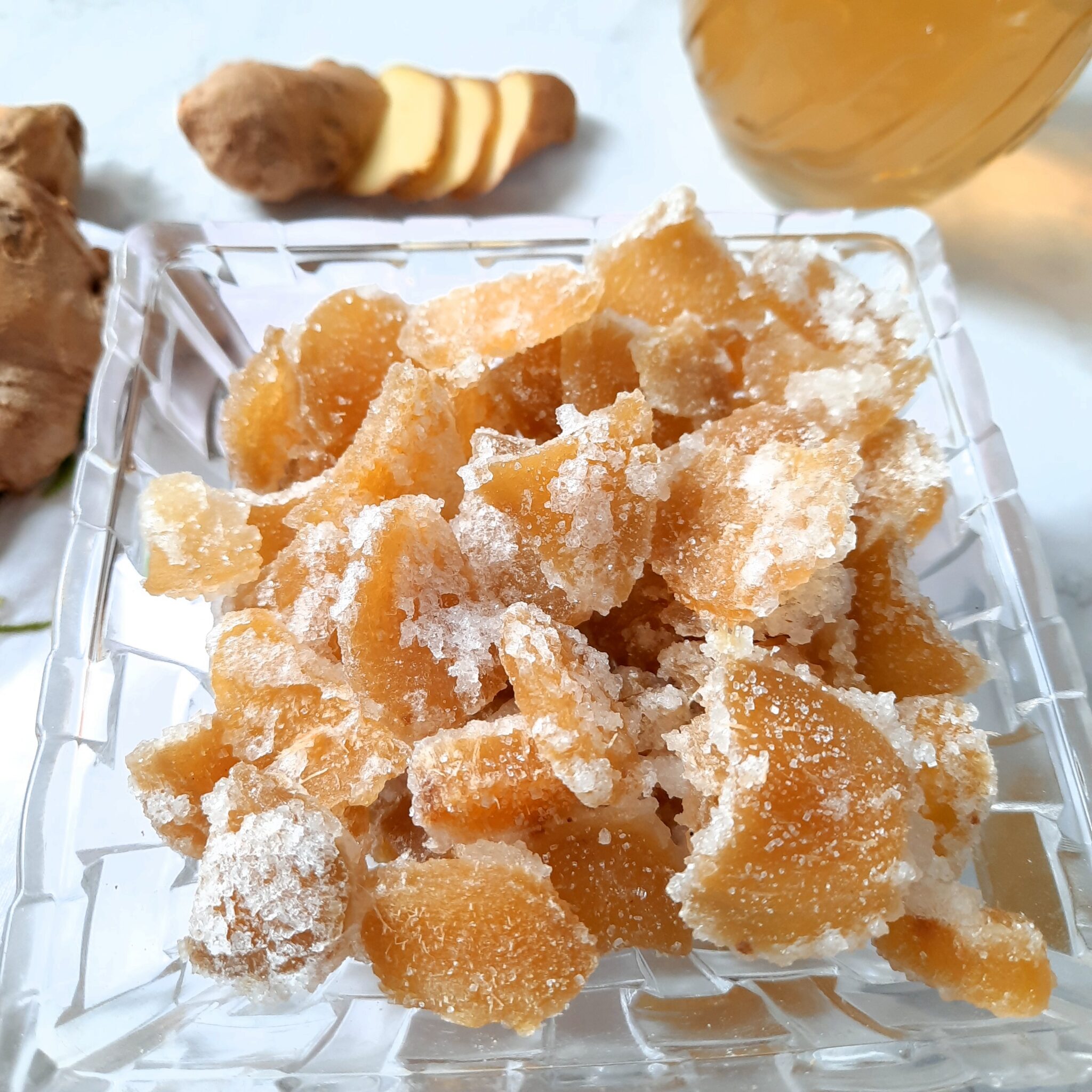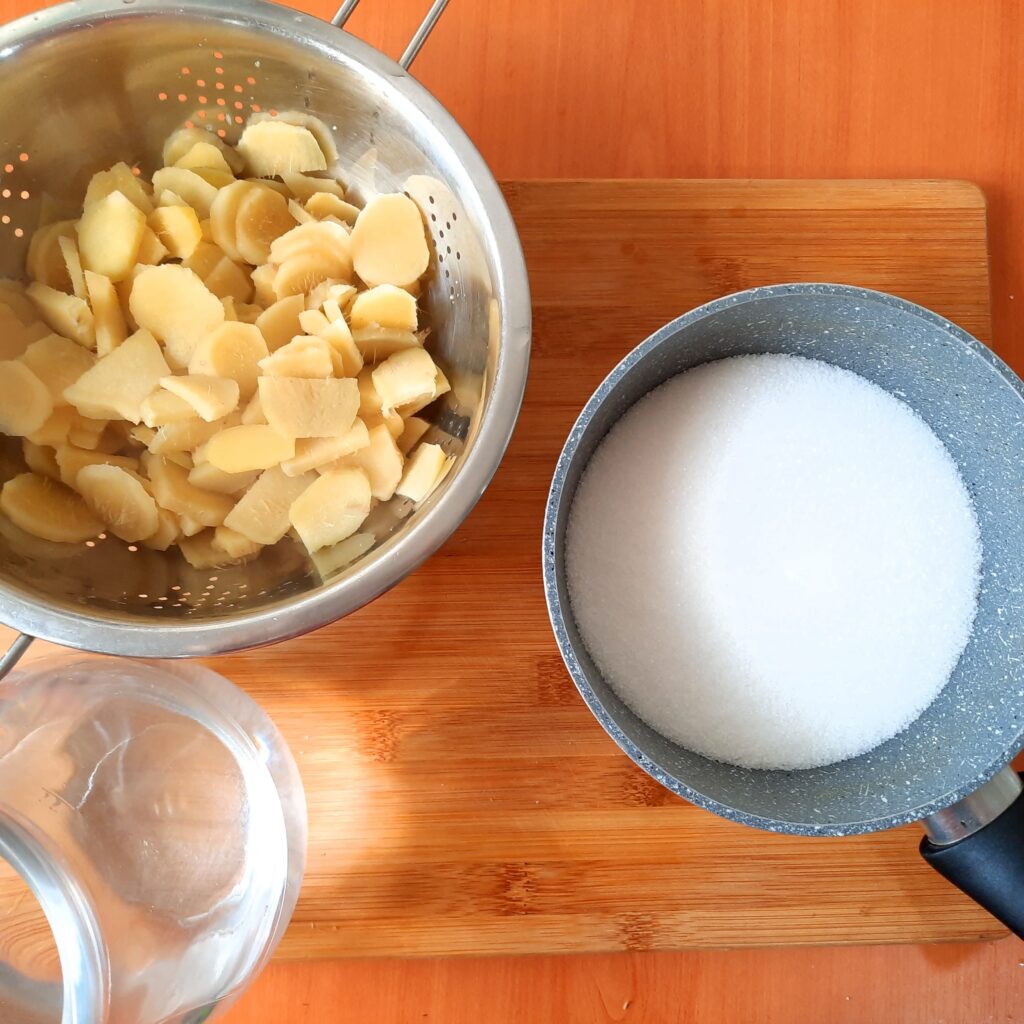Crystallized Ginger (also called Candied Ginger or Glace Ginger) is a delicious exotic treat with a pungent and spicy-sweet flavor. It tastes spicy, lemony, and sweet at the same time with a familiar sweetness before the heat takes over. Identifiable by its yellowish color, this treat can be easily made at home to enjoy with baked goods or an everyday meal.
History and origin
Ginger (Zingiber officinale) is a flowering plant whose rhizome, ginger root or ginger, is widely used as a spice and folk medicine. It is from the family Zingiberaceae and is closely related to galangal, turmeric, and cardamom. Technically speaking, ginger is a rhizome and not a root. Rhizomes are plant stem that produces roots below ground and produces shoots above the ground.
The word ginger comes a long way, but its origin goes back to the Sanskrit word “srngaveram” (pronounced singabera) which means “shaped like a deer’s antlers” or “horn body” and describes its root. After that, the word became gingiber in late Latin. Then Old English picked it up and made it gingifer, which finally became what we know today as ginger.
Ginger first appeared in the southern parts of ancient China. From there, it spread to India, Maluku Islands (so-called Spice Islands), rest of the Asia, and West Africa. Europe saw ginger for the first time in the 1st century when the ancient Romans traded with India. When Rome fell, Europe forgot about ginger until Marco Polo brought it again from his travel to the East. In the Middle Ages, ginger was very pricy as half a kilogram of ginger was the same as of one sheep. In the 15th century, with the rediscovery of the New World, Ginger was brought to the Caribbean where it started to grow with ease. Today, India is the greatest producer of ginger in the world.
Candied fruits are a centuries-old delicacy in most of Asia, but the blend of sugar and fruit is also well-known throughout the world. Crystallized ginger was spoken of in the Jewish Talmud, and even Henry VIII suggested it as a remedy against the plague. Urban legend has some folks saying that it helped alleviate the symptoms of motion sickness on boats. Ginger, whether crystallized or not, is also considered a good remedy for nausea. Today, it is thought to be a strong antioxidant to prevent cancers ranging from gastrointestinal to skin, and as an antimicrobial against E. coli.
Tips and notes
Crystallized ginger comes in two forms. The first is a crystallized ginger that has been rolled in sugar crystals after it has finished cooking. The second, what people typically refer to as candied ginger, is cooked the exact same way but it has not been rolled in sugar crystals after it has finished cooking.
Typically, to make crystallized ginger, young ginger roots are harvested, washed, peeled, hand-cut, and water blanched. The root pieces are then dipped in a cane sugar (or fruit juice) solution, rolled in cane sugar, and placed in an oven. Young ginger rhizomes are the most suitable for this process since they are softer and have a milder flavor.
Here are some tips to prepare crystallized ginger:
- When peeling the ginger, a nifty trick is to use a soup spoon and holding it so the bowl of the spoon is facing the ginger, scraping away the skin with the edge of the spoon. You can even get easily around all the nooks and knobs using that method.
- Slice the ginger as thinly as possible, which also helps ensure there won’t be stringy bits in your finished candied ginger. For that, make sure that your knife is very sharp and medium or large-sized.
- Take the ginger slices out of the syrup using a slotted spoon and drain off the excess syrup before rolling them into sugar.
- It’s preferable to use young ginger (usually available in the spring), which is more tender and has fewer fibers.
- Although it’s recommended to use a candy thermometer, if you don’t have one, simply keep an eye on the pot of ginger while it’s cooking in the syrup. When the liquid is the consistency of maple syrup and the bubbles are thick, it’s done.
- The ginger, packed in its syrup, can be stored in the refrigerator for up to one year. If the ginger is tossed in sugar, the pieces can be stored at room temperature or in the refrigerator for a few months.
Serving
Candied ginger is most frequently used in desserts and baked goods or as an after-dinner snack or with cups of tea. It is used in holiday recipes such as pies, puddings, or to decorate the top of cakes.
It can also be used as a condiment with curry, minced and served with chutney, alongside cream cheese, and with fruit desserts.
Candied ginger is sometimes mixed with soy sauce to use on vegetables and egg rolls, and can add an extra flavor dimension to vanilla ice cream.
Variants
- Candied orange/citrus peels;
- Candied citron;
- Maraschino cherry;
- Tanghulu;
- Italian Mostarda;
- Chinese Chenpi;
- Candy apple;
- …
Crystallized Ginger
Ingredients
- 200 g fresh ginger
- 400 g sugar
- 2 g salt
- 250 ml water
- 150 g sugar, for coating (optional)
Instructions
- Slice the ginger as thinly as possible, about ⅛ in (3mm)
- In a pot, put the ginger slices and salt, then add enough water to cover the ginger.
- Bring to a boil, then reduce the heat and let ginger simmer for ten minutes (10 min). Drain the water and repeat this step a second time.
- Mix the sugar and the water in the pot, along with the ginger slices, and cook at medium heat until the temperature reaches 225ºF (106ºC), for about 35-45 minutes.
- Remove from heat and let sit overnight or at least an hour.
- To coat the slices with sugar, gently rewarm the ginger and strain the ginger through a strainer, 30 to 60 minutes.
- Toss the drained slices in granulated sugar.
- Shake off excess sugar and lay the crystallized ginger on the cooling rack to sit for 24 hours (or more, depending on the humidity) to dry. You can also dry them in a food dehydrator or in the oven on the very lowest temperature setting.
Sources: 1. https://en.wikipedia.org/wiki/Ginger 2. http://www.vegetablefacts.net/vegetable-history/ginger-history/











































